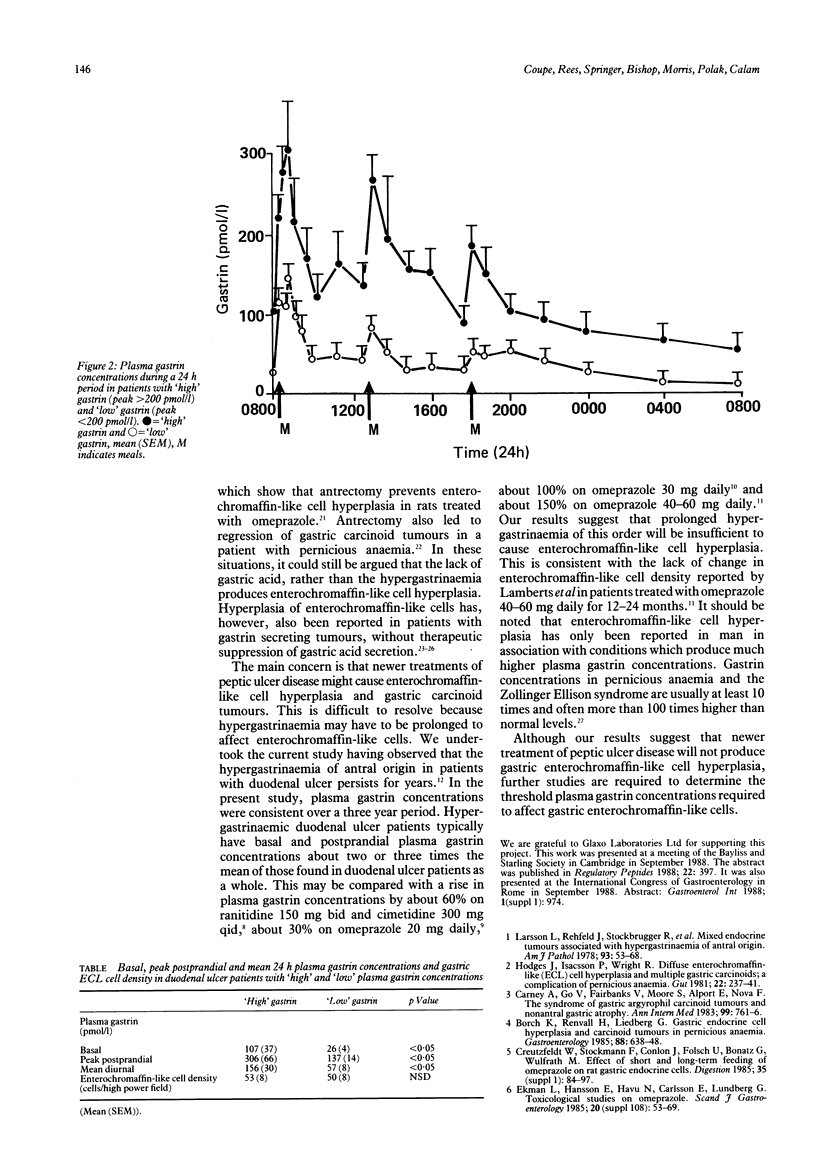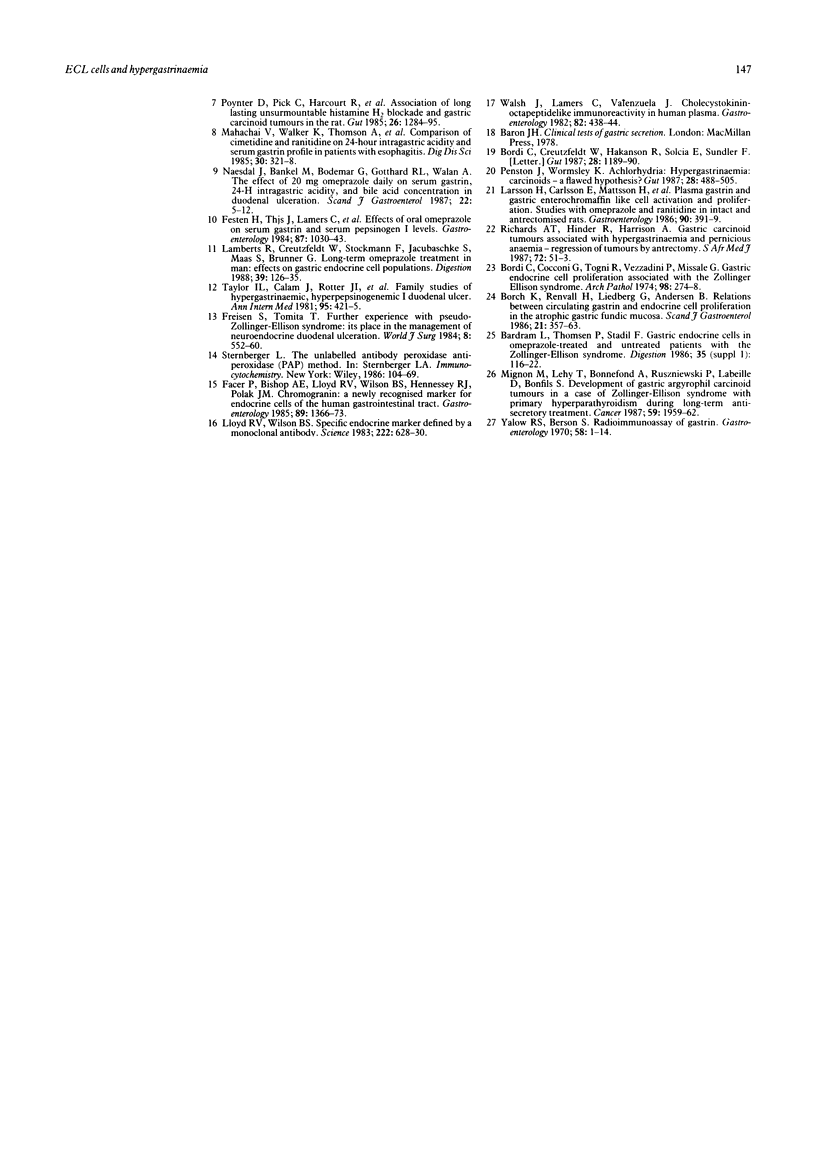Abstract
Patients with hypergastrinaemic duodenal ulcer disease were studied to determine whether chronic moderate hypergastrinaemia produces hyperplasia of gastric enterochromaffin-like cells in man. Eight patients had peak postprandial plasma gastrin concentrations greater than 200 pmol/l, which is the 92nd percentile for patients with duodenal ulcer disease in this laboratory. The control group was eight patients with duodenal ulcers whose peak postprandial gastrin concentrations were less than 200 pmol/l. Basal and peak postprandial plasma gastrin concentrations were 107 (37) and 306 (66) pmol/l (mean (SEM] respectively in the hypergastrinaemic patients compared with 26 (4) and 137 (14) pmol/l respectively in the controls. There was no significant difference in the density of gastrin enterochromaffin-like cells between the two groups. The number of enterochromaffin-like cells per high power field was 53 (8) in the hypergastrinaemic patients compared with 50 (8) in the controls. We conclude that chronic moderate hypergastrinaemia does not produce hyperplasia of enterochromaffin-like cells in man. Our hypergastrinaemic group had plasma gastrin concentrations similar to, or greater than those reported during treatment with drugs such as omeprazole and histamine H2 receptor blockers.
Full text
PDF



Images in this article
Selected References
These references are in PubMed. This may not be the complete list of references from this article.
- Bardram L., Thomsen P., Stadil F. Gastric endocrine cells in omeprazole-treated and untreated patients with the Zollinger-Ellison syndrome. Digestion. 1986;35 (Suppl 1):116–122. doi: 10.1159/000199387. [DOI] [PubMed] [Google Scholar]
- Borch K., Renvall H., Liedberg G., Andersen B. N. Relations between circulating gastrin and endocrine cell proliferation in the atrophic gastric fundic mucosa. Scand J Gastroenterol. 1986 Apr;21(3):357–363. doi: 10.3109/00365528609003087. [DOI] [PubMed] [Google Scholar]
- Borch K., Renvall H., Liedberg G. Gastric endocrine cell hyperplasia and carcinoid tumors in pernicious anemia. Gastroenterology. 1985 Mar;88(3):638–648. doi: 10.1016/0016-5085(85)90131-3. [DOI] [PubMed] [Google Scholar]
- Bordi C., Cocconi G., Togni R., Vezzadini P., Missale G. Gastric endocrine cell proliferation. Association with Zollinger-Ellison syndrome. Arch Pathol. 1974 Oct;98(4):274–278. [PubMed] [Google Scholar]
- Bordi C., Creutzfeldt W., Håkanson R., Solcia E., Sundler F. Achlorhydria: hypergastrinaemia: carcinoids--a flawed hypothesis. Gut. 1987 Sep;28(9):1189–1192. doi: 10.1136/gut.28.9.1189. [DOI] [PMC free article] [PubMed] [Google Scholar]
- Carney J. A., Go V. L., Fairbanks V. F., Moore S. B., Alport E. C., Nora F. E. The syndrome of gastric argyrophil carcinoid tumors and nonantral gastric atrophy. Ann Intern Med. 1983 Dec;99(6):761–766. doi: 10.7326/0003-4819-99-6-761. [DOI] [PubMed] [Google Scholar]
- Creutzfeldt W., Stöckmann F., Conlon J. M., Fölsch U. R., Bonatz G., Wülfrath M. Effect of short- and long-term feeding of omeprazole on rat gastric endocrine cells. Digestion. 1986;35 (Suppl 1):84–97. doi: 10.1159/000199384. [DOI] [PubMed] [Google Scholar]
- Ekman L., Hansson E., Havu N., Carlsson E., Lundberg C. Toxicological studies on omeprazole. Scand J Gastroenterol Suppl. 1985;108:53–69. [PubMed] [Google Scholar]
- Facer P., Bishop A. E., Lloyd R. V., Wilson B. S., Hennessy R. J., Polak J. M. Chromogranin: a newly recognized marker for endocrine cells of the human gastrointestinal tract. Gastroenterology. 1985 Dec;89(6):1366–1373. doi: 10.1016/0016-5085(85)90657-2. [DOI] [PubMed] [Google Scholar]
- Festen H. P., Thijs J. C., Lamers C. B., Jansen J. M., Pals G., Frants R. R., Défize J., Meuwissen S. G. Effect of oral omeprazole on serum gastrin and serum pepsinogen I levels. Gastroenterology. 1984 Nov;87(5):1030–1034. [PubMed] [Google Scholar]
- Friesen S. R., Tomita T. Further experience with Pseudo-Zollinger-Ellison syndrome: its place in the management of neuroendocrine duodenal ulceration. World J Surg. 1984 Aug;8(4):552–560. doi: 10.1007/BF01654936. [DOI] [PubMed] [Google Scholar]
- Hodges J. R., Isaacson P., Wright R. Diffuse enterochromaffin-like (ECL) cell hyperplasia and multiple gastric carcinoids: a complication of pernicious anaemia. Gut. 1981 Mar;22(3):237–241. doi: 10.1136/gut.22.3.237. [DOI] [PMC free article] [PubMed] [Google Scholar]
- Lamberts R., Creutzfeldt W., Stöckmann F., Jacubaschke U., Maas S., Brunner G. Long-term omeprazole treatment in man: effects on gastric endocrine cell populations. Digestion. 1988;39(2):126–135. doi: 10.1159/000199615. [DOI] [PubMed] [Google Scholar]
- Larsson H., Carlsson E., Mattsson H., Lundell L., Sundler F., Sundell G., Wallmark B., Watanabe T., Håkanson R. Plasma gastrin and gastric enterochromaffinlike cell activation and proliferation. Studies with omeprazole and ranitidine in intact and antrectomized rats. Gastroenterology. 1986 Feb;90(2):391–399. doi: 10.1016/0016-5085(86)90938-8. [DOI] [PubMed] [Google Scholar]
- Larsson L. I., Rehfeld J. F., Stockbrügger R., Blohme G., Schön I. M., Lundqvist G., Kindblom L. G., Säve-Söderberg J., Grimelius L., Olbe L. Mixed endocrine gastric tumors associated with hypergastrinemia of antral origin. Am J Pathol. 1978 Oct;93(1):53–68. [PMC free article] [PubMed] [Google Scholar]
- Lloyd R. V., Wilson B. S. Specific endocrine tissue marker defined by a monoclonal antibody. Science. 1983 Nov 11;222(4624):628–630. doi: 10.1126/science.6635661. [DOI] [PubMed] [Google Scholar]
- Mahachai V., Walker K., Thomson A. B., Zuk L., Kirdeikis P., Fisher D., Brunet K. Comparison of cimetidine and ranitidine on 24-hour intragastric acidity and serum gastrin profile in patients with esophagitis. Dig Dis Sci. 1985 Apr;30(4):321–328. doi: 10.1007/BF01403840. [DOI] [PubMed] [Google Scholar]
- Mignon M., Lehy T., Bonnefond A., Ruszniewski P., Labeille D., Bonfils S. Development of gastric argyrophil carcinoid tumors in a case of Zollinger-Ellison syndrome with primary hyperparathyroidism during long-term antisecretory treatment. Cancer. 1987 Jun 1;59(11):1959–1962. doi: 10.1002/1097-0142(19870601)59:11<1959::aid-cncr2820591120>3.0.co;2-z. [DOI] [PubMed] [Google Scholar]
- Naesdal J., Bankel M., Bodemar G., Gotthard R., Lundquist G., Walan A. The effect of 20 Mg omeprazole daily on serum gastrin, 24-h intragastric acidity, and bile acid concentration in duodenal ulcer patients. Scand J Gastroenterol. 1987 Jan;22(1):5–12. doi: 10.3109/00365528708991848. [DOI] [PubMed] [Google Scholar]
- Penston J., Wormsley K. G. Achlorhydria: hypergastrinaemia: carcinoids--a flawed hypothesis? Gut. 1987 Apr;28(4):488–505. doi: 10.1136/gut.28.4.488. [DOI] [PMC free article] [PubMed] [Google Scholar]
- Poynter D., Pick C. R., Harcourt R. A., Selway S. A., Ainge G., Harman I. W., Spurling N. W., Fluck P. A., Cook J. L. Association of long lasting unsurmountable histamine H2 blockade and gastric carcinoid tumours in the rat. Gut. 1985 Dec;26(12):1284–1295. doi: 10.1136/gut.26.12.1284. [DOI] [PMC free article] [PubMed] [Google Scholar]
- Taylor I. L., Calam J., Rotter J. I., Vaillant C., Samloff I. M., Cook A., Simkin E., Dockray G. J. Family studies of hypergastrinemic, hyperpepsinogenemic I duodenal ulcer. Ann Intern Med. 1981 Oct;95(4):421–425. doi: 10.7326/0003-4819-95-4-421. [DOI] [PubMed] [Google Scholar]
- Walsh J. H., Lamers C. B., Valenzuela J. E. Cholecystokinin-octapeptidelike immunoreactivity in human plasma. Gastroenterology. 1982 Mar;82(3):438–444. [PubMed] [Google Scholar]
- Yalow R. S., Berson S. A. Radioimmunoassay of gastrin. Gastroenterology. 1970 Jan;58(1):1–14. [PubMed] [Google Scholar]



